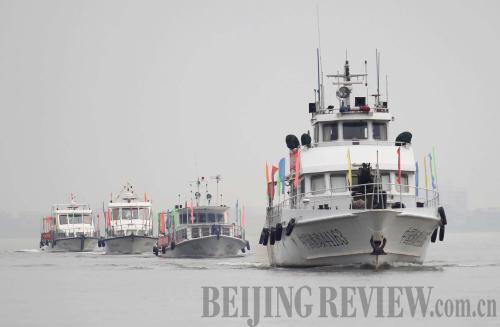|
 |
|
INTENSIFIED MONITORING: Surveillance boats of fishery authorities patrol the Xijiang River, a main tributary of the Pearl River on April 1, to enforce a fishing ban in the waterway (CFP) |
Since April 1, a two-month ban on fishing has been imposed on the Pearl River valley in south China. It is the first fishing ban in this area with the purpose of preserving biodiversity in China's third longest river and improving the water quality.
The Pearl River is also China's second largest waterway in terms of run-off volume. It runs through six provincial divisions on the mainland, including Yunnan, Guizhou, Jiangxi, Hunan and Guangdong provinces and Guangxi Zhuang Autonomous Region, as well as Hong Kong and Macao. The ban will be applied to the mainstream of the river, and all its tributaries and lakes connected with them. The total length affected is 5,365 km, said the Fishery Administration of the Ministry of Agriculture.
Severe conditions
The Pearl River was once home to 400 varieties of fish, including many rare species such as Chinese sturgeon and giant salamanders. They accounted for more than half of freshwater fish species found in China.
"But years of over-fishing and increasing construction work over the river have led to a decline in fishing output and some rare species have not been seen for years," said Li Yanliang, Deputy Director of the Fishery Administration under the Ministry of Agriculture.
According to samples collected near the biggest spawning site along the Pearl River, both the number of individual fish and the number of fish species had declined significantly during the past three years, said Li.
Despite this, there are still a large number of people living on fishing in the river. For example, a 200-km section of the river between Guangxi and Guangdong now supports more than 5,000 fishermen, a number that is far beyond the section's capacity.
Li also said numbers of many types of common freshwater fish have decreased as a result of changes in the aquatic environment in the Pearl River.
The four major species of freshwater fish in China—black carp, grass carp, silver carp and crucian carp—had become more and more uncommon as their spawning rates had fallen, while the number of alien species had risen, Li said.
"We've been following aquatic biodiversity in the Pearl River since the 1990s," said Wu Zhuang, Director of the Bureau of Fishery Administration and Fishing Port Superintendence in the South China Sea Region, Ministry of Agriculture. "In 2002, the Pearl River Fishery Management Commission was set up and it has conducted research along the river for several years on the fishing conditions."
Besides over-fishing, there are other reasons for the decline of varieties of fish in the Pearl River.
"Nearly 1,300 hydropower stations and 96,500 water conservancy works on the Pearl River and its tributaries have hindered the propagation of some fish species," he said.
Wu said since traditional places to spawn are blocked by hydro projects, fish are forced to lay eggs before arriving at desired destinations. As a result, their young have slimmer chances of surviving largely because their migration routes back to the ocean are not long enough to allow them to mature.
"Meanwhile, an increasing number of environmental emergencies in recent years have also polluted water and killed fish," said Wu. "More dam projects and deterioration in water quality are also major threats to the ecosystem in the Pearl River."
China's Fishery Eco-environment Report said 165 pollution incidents occurred in the Pearl River in 2009, leading to losses totaling 56 million yuan ($8.55 million).
"Estimates suggest more than 260 fish species in the Pearl River will face extinction in the next five to 10 years because of existing and planned dam projects along the river and its tributaries," said Li Xinhui, a researcher with the Pearl River Fisheries Research Institute under the Chinese Academy of Fishery Sciences. "The dams have disrupted the migration routes taken by fish species and changed the environment of their spawning places."
Great expectations
It is not the first such ban in China. In 2003, an annual three-month fishing ban from February 1 to April 30, the spring season when fish lay eggs, was imposed on the Yangtze River, China's longest waterway. The ban covers the entire Yangtze River, which goes through 10 provinces, autonomous regions and municipalities in south and east China.
The ban on the Yangtze River has proved effective. Take mitten crab for example. In 2000, there was almost no crab output in the river; while in 2007, the output surpassed 10 tons thanks to a few years of a fishing moratorium, according to statistics from the Ministry of Agriculture.
But the fish and animal species are no longer as abundant as they once were. During the past two decades, the extent of the upper reaches of the Yangtze River occupied by rare and endangered fish has been reduced from thousands of kilometers to just 200 km.
Considering this, fishery authorities planned to put some 6 million fish into the Pearl River during this year's fishing ban period to sustain its fishery resources.
On April 1, the first day of the ban, fishermen in Guigang City, Guangxi, put 1.5 million fish fries into water.
"Eventually, fishermen will earn more since fishing output will increase after the two months come to an end," said Liu Tianrong, Deputy Director of the Bureau of Fishery Administration and Fishing Port Superintendence in the South China Sea Region under the Ministry of Agriculture.
| 